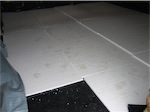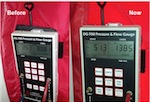Reducing Fading With Low-E
The spectral selectivity of low-E coatings also allows them to block significant amounts of ultraviolet (UV) light. Research into the fading of fabrics, artwork, finishes, and home furnishings has shown that the radiant energy that affects fading includes portions of the visible light spectrum in addition to UV. The International Organization for Standardization (ISO) has proposed a damage-weighted scale called Tdw-ISO that accounts for the effects of both UV and visible light. The ratings for low-E glass (Figure 7) suggest that low-solar-gain low-E glass with a rating of 0.43 would reduce the rate of fading by over 40 percent compared with clear glass rated at 0.74.
It’s not appropriate to claim that a glass type can “eliminate” fading altogether. If light passes through, there will always be a risk of fading. Also, the rate of fading will vary with the type of material and the exposure levels. Keeping a sensitive material out of direct sunlight is always a good idea.
Comfort Is the Issue
A study commissioned by Pacific Gas and Electric several years ago discovered that the number one reason customers make energy-efficiency improvements to their homes is to increase their comfort. Windows have a huge impact on comfort. When it is 40 deg F outside, the inside surface temperature of a single-pane window can be 20 deg F colder than room temperature. Since our bodies radiate heat to colder surfaces, a room full of poorly insulating windows can make us feel uncomfortable (by radiant cooling) even if the home is well insulated. High-performance technologies can make windows feel warmer during cold weather by keeping the temperature of the interior glass surface higher (Figure 8).
In warm weather, clear glass and high-solar-gain low-E will increase cooling loads and air-conditioner size. The combination of high solar gains along with the hot inside glass temperature, would require cooling thermostats set anywhere from 2°F to 4°F lower to provide the same comfort regimen as the medium or low solar-gain low-E.
In cold climates, solar gain can be used to offset heat losses, but this requires a system design approach. Windows should face south for best winter sun exposure, and overhangs should be designed to shade the glass in the spring and fall. If large amounts of south-facing glass are used, the building should be designed by an experienced solar designer, and it may need thermal mass to absorb solar gains and a circulation system to distribute the stored gains. Even with all this, many passive-solar buildings experience daily temperature swings that are beyond the comfort expectations of most homeowners.
Choosing the optimal glazing type for both winter and summer performance can be tricky. However, computer modeling indicates that the sweet spot for most homes in the U.S is argon-filled double glazing with medium-solar-gain low-E (SHGC from 0.25 to 0.35, U-factor of 0.28 to 0.32). This will provide warm inside glass temperatures on cold winter nights and limit unwanted heat gain in summer. In hot southern climates, it makes sense to use the lowest SHGC available.







